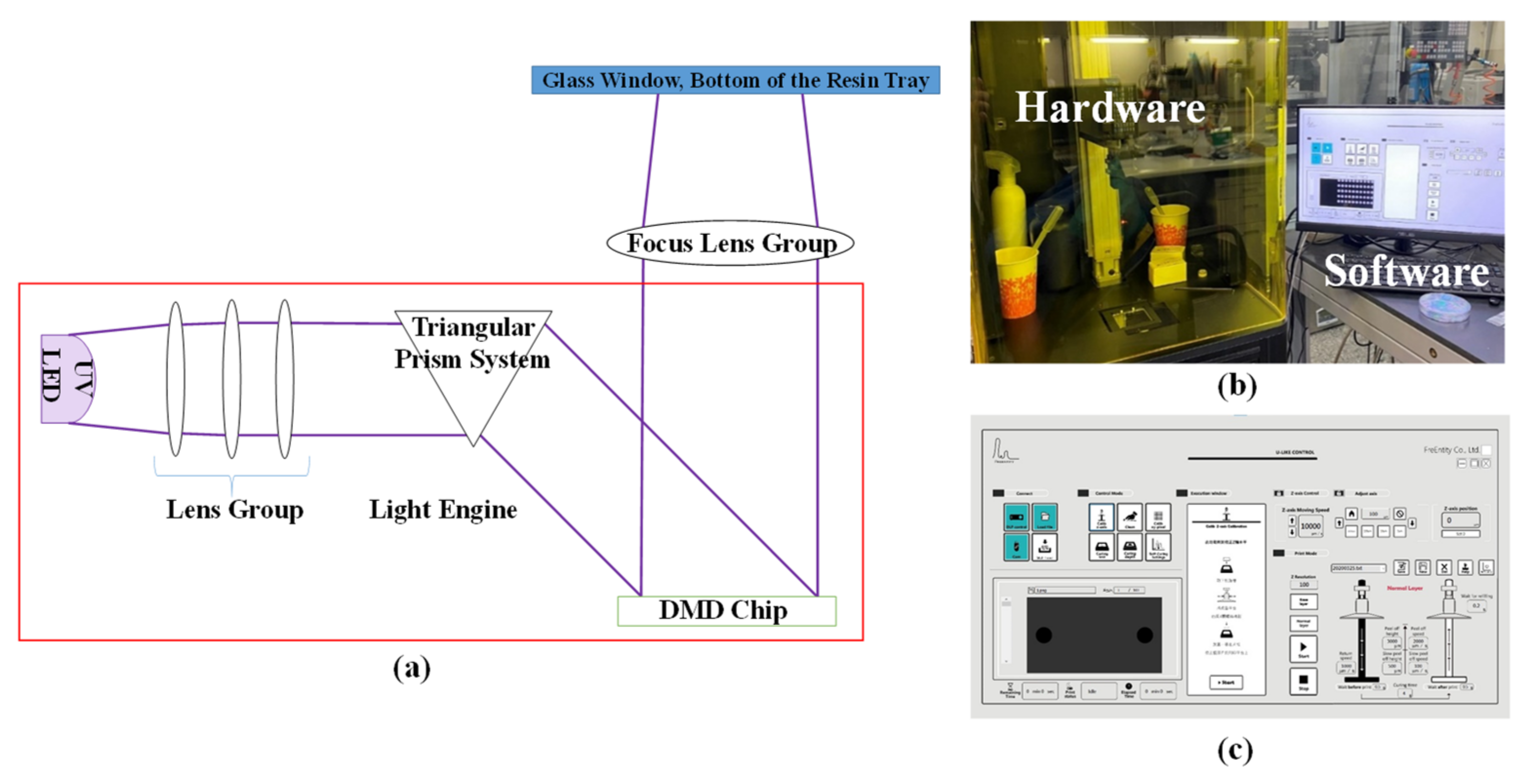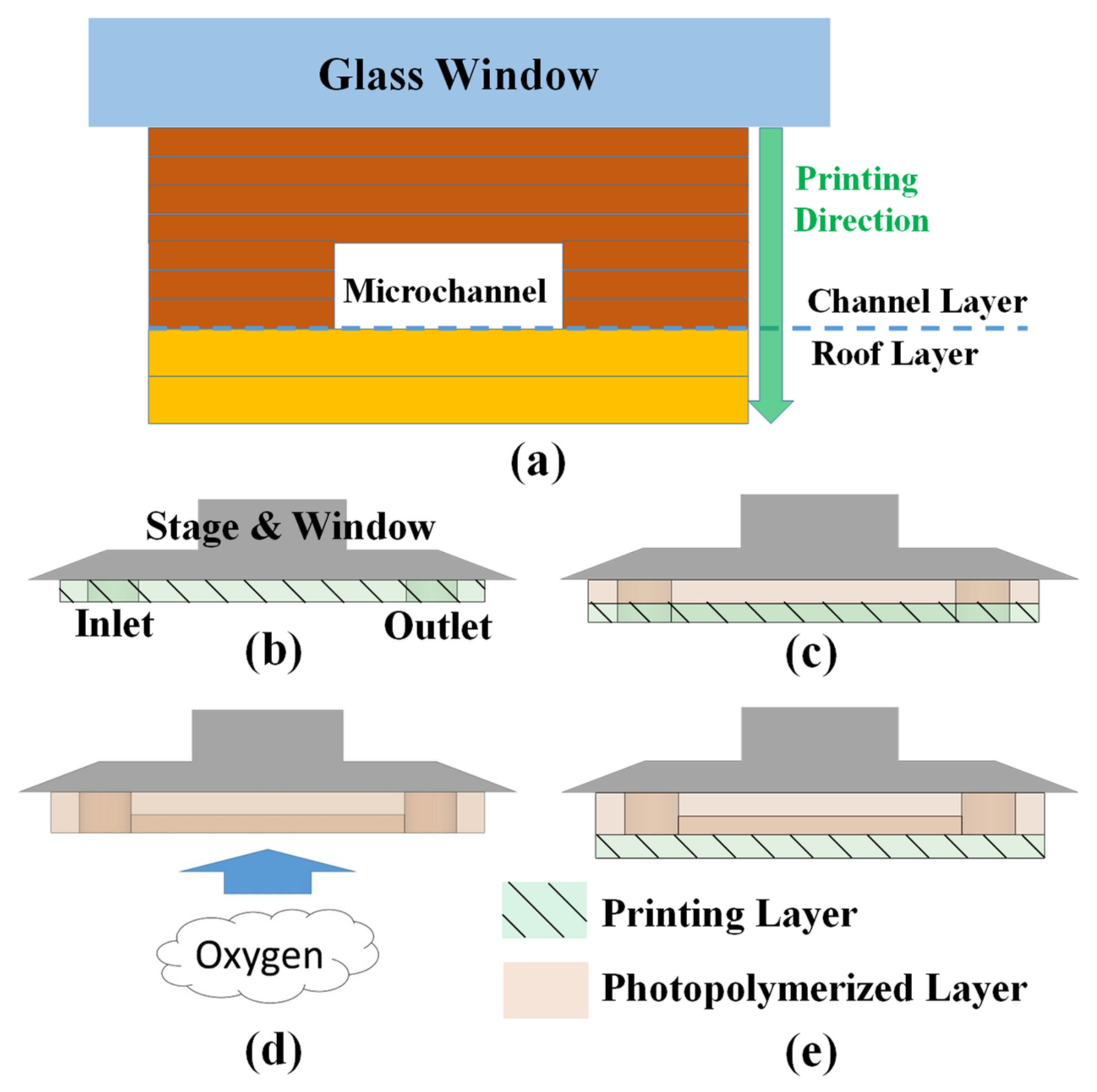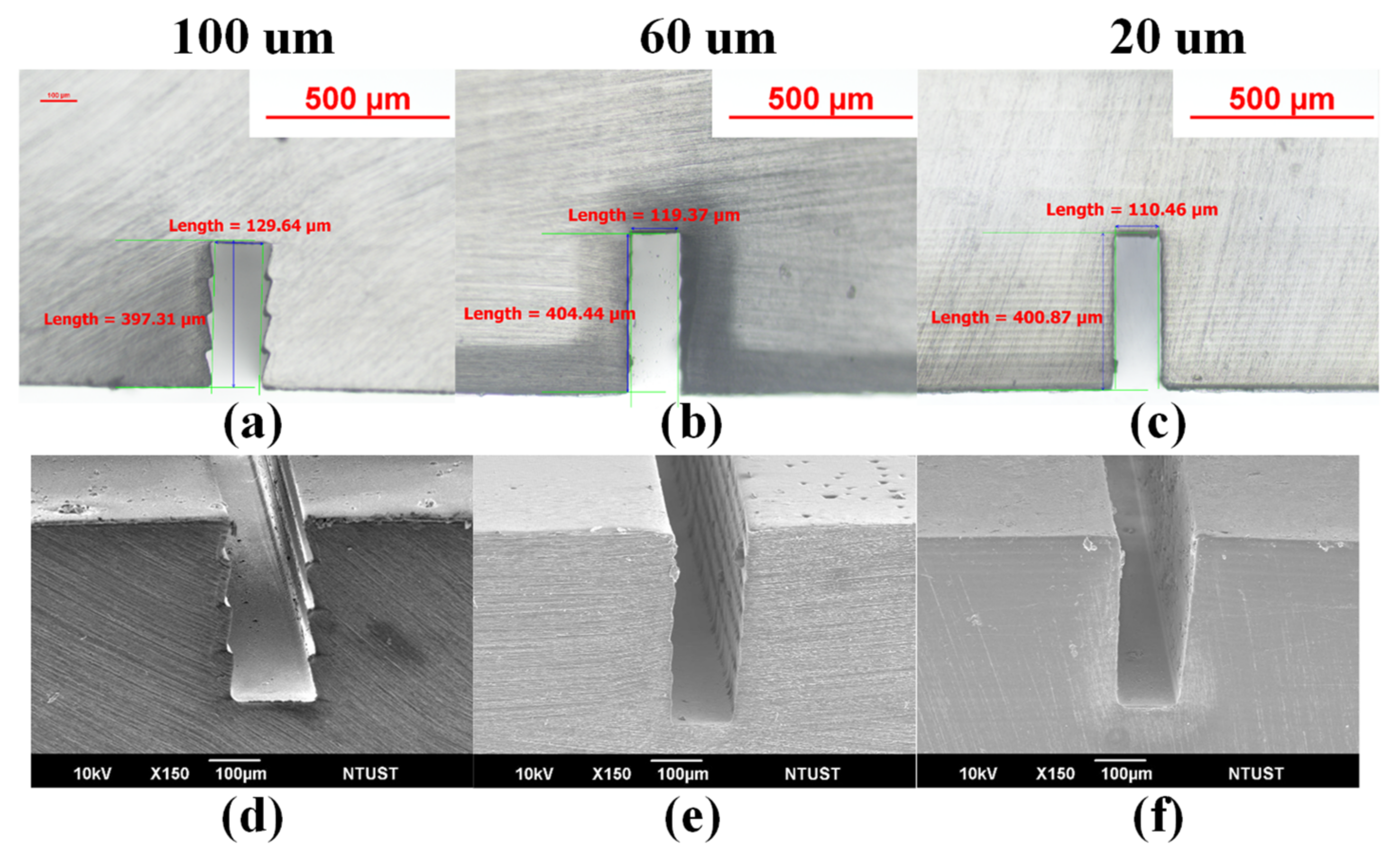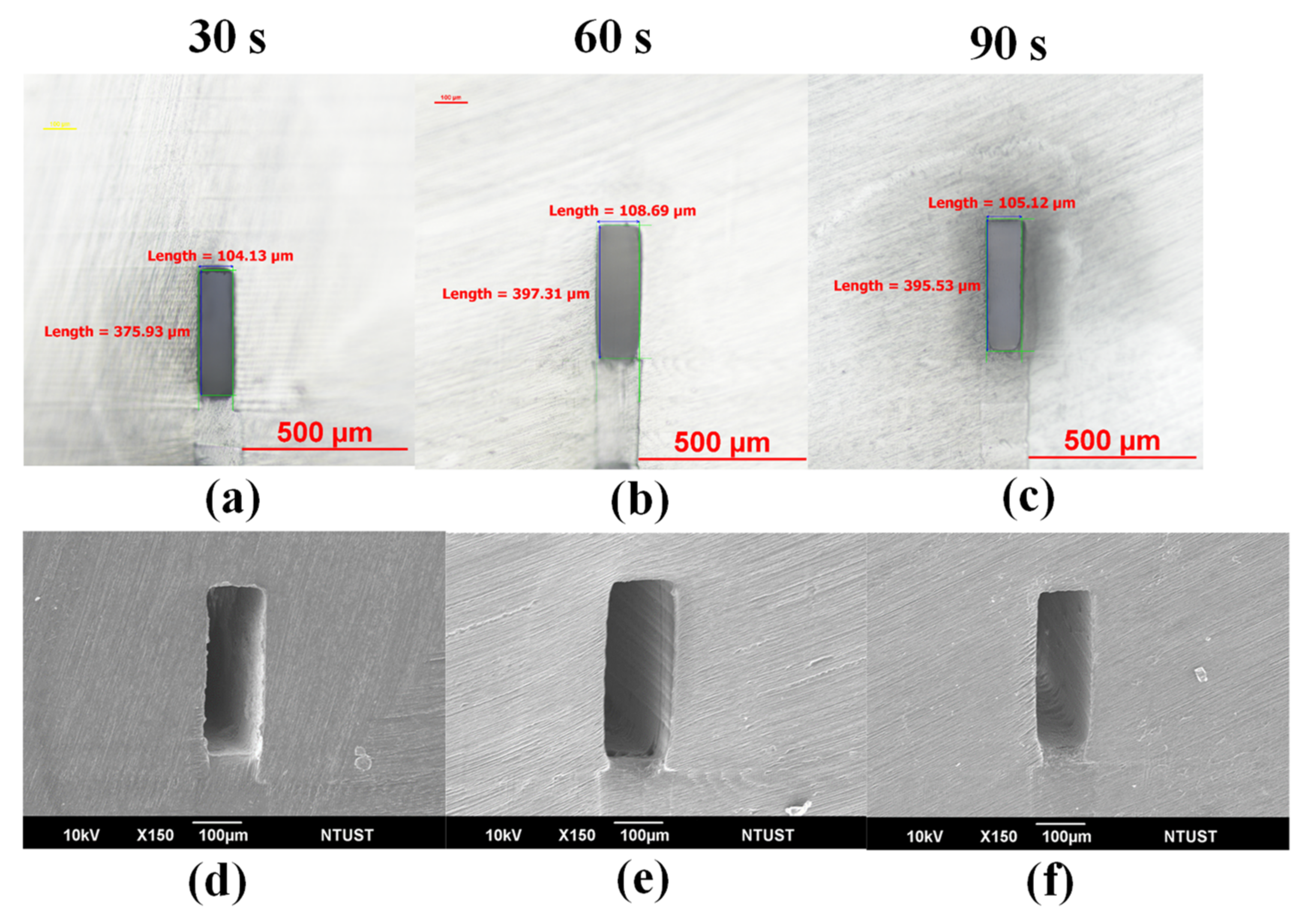Using Stereolithographic Printing to Manufacture Monolithic Microfluidic Devices with an Extremely High Aspect Ratio
Abstract
:1. Introduction
2. Materials and Methods
2.1. Materials and Apparatus
2.2. Three-Step Printing Process
2.3. Printing Thickness of the Quality of the Microchannels
2.4. Oxygen Inhibition to the Quality of the Microchannels
2.5. Microchannels with a High Aspect Ratio
3. Results
3.1. Printing Thickness to the Microchannel Quality
3.2. Oxygen Inhibition on the Microchannel Quality
4. Monolithic Microchannels with High Aspect Ratios
5. Conclusions
Supplementary Materials
Author Contributions
Funding
Institutional Review Board Statement
Informed Consent Statement
Data Availability Statement
Conflicts of Interest
References
- Terry, S.C.; Jerman, J.H.; Angell, J.B. A gas chromatographic air analyzer fabricated on a silicon wafer. IEEE transactions on electron devices. IEEE Trans. Electron Devices 1979, 26, 1880–1886. [Google Scholar] [CrossRef]
- Lynh, H.D.; Pin-Chuan, C. Novel solvent bonding method for creation of a three-dimensional, non-planar, hybrid PLA/PMMA microfluidic chip. Sens. Actuator A Phys. 2018, 280, 350–358. [Google Scholar] [CrossRef]
- Tsao, C.W.; Huang, Q.Z.; You, C.Y.; Hilpert, M.; Hsu, S.Y.; Lamorski, K.; Sławiński, C. The effect of channel aspect ratio on air entrapment during imbibition in soil-on-a-chip micromodels with 2D and 2.5 D pore structures. Lab Chip 2021, 21, 385–396. [Google Scholar] [CrossRef]
- Park, T.; Song, I.H.; Park, D.S.; You, B.H.; Murphy, M.C. Thermoplastic fusion bonding using a pressure-assisted boiling point control system. Lab Chip 2012, 12, 2799–2802. [Google Scholar] [CrossRef] [PubMed]
- Fujii, T. PDMS-based microfluidic devices for biomedical applications. Microelectron. Eng. 2002, 61, 907–914. [Google Scholar] [CrossRef]
- Villegas, M.; Cetinic, Z.; Shakeri, A.; Didar, T.F. Fabricating smooth PDMS microfluidic channels from low-resolution 3D printed molds using an omniphobic lubricant-infused coating. Anal. Chim. Acta 2018, 1000, 248–255. [Google Scholar] [CrossRef]
- Rodriguez, I.; Spicar-Mihalic, P.; Kuyper, C.L.; Fiorini, G.S.; Chiu, D.T. Rapid prototyping of glass microchannels. Anal. Chim. Acta 2003, 496, 205–215. [Google Scholar] [CrossRef]
- Shih, C.I.; Chou, Y.C.; Chen, H.Y.; Chen, K.H.; Wang, I.H.; Yeh, Y.C. Colorimetric and Fluorometric Paper-Based Assay for Cu2+ Detection Based on Green Synthesis of 2-Aminoterephthalic Acid-Derived Pigments. ACS Appl. Bio Mater. 2020, 3, 2516–2521. [Google Scholar] [CrossRef]
- Chen, C.A.; Yuan, H.; Chen, C.W.; Chien, Y.S.; Sheng, W.H.; Chen, C.F. An electricity-and instrument-free infectious disease sensor based on a 3D origami paper-based analytical device. Lab Chip 2021, 21, 1908–1915. [Google Scholar] [CrossRef]
- Ngo, T.D.; Kashani, A.; Imbalzano, G.; Nguyen, K.T.; Hui, D. Additive manufacturing (3D printing): A review of materials, methods, applications and challenges. Compos. B Eng. 2018, 143, 172–196. [Google Scholar] [CrossRef]
- Chen, P.C.; Duong, L.H. Novel solvent bonding method for thermoplastic microfluidic chips. Sens. Actuators B Chem. 2016, 237, 556–562. [Google Scholar] [CrossRef]
- Yao, T.F.; Yang, S.Y. CO 2-assisted thermal fusion bonding of heterogeneous materials by use of surface nano-pillars. Microsyst. Technol. 2013, 19, 151–157. [Google Scholar] [CrossRef] [Green Version]
- Au, A.K.; Huynh, W.; Horowitz, L.F.; Folch, A. 3D-printed microfluidics. Angew. Chem. Int. Ed. 2016, 55, 3862–3881. [Google Scholar] [CrossRef] [PubMed]
- Piironen, K.; Haapala, M.; Talman, V.; Järvinen, P.; Sikanen, T. Cell adhesion and proliferation on common 3D printing materials used in stereolithography of microfluidic devices. Lab Chip 2020, 20, 2372–2382. [Google Scholar] [CrossRef]
- Snowden, M.E.; King, P.H.; Covington, J.A.; Macpherson, J.V.; Unwin, P.R. Fabrication of versatile channel flow cells for quantitative electroanalysis using prototyping. Anal. Chem. 2010, 82, 3124–3131. [Google Scholar] [CrossRef] [PubMed]
- Romanov, V.; Samuel, R.; Chaharlang, M.; Jafek, A.R.; Frost, A.; Gale, B.K. FDM 3D printing of high-pressure, heat-resistant, transparent microfluidic devices. Anal. Chem. 2018, 90, 10450–10456. [Google Scholar] [CrossRef]
- Nielsen, A.V.; Beauchamp, M.J.; Nordin, G.P.; Woolley, A.T. 3D printed microfluidics. Annu. Rev. Anal. Chem. 2020, 13, 45–65. [Google Scholar] [CrossRef]
- Gong, H.; Beauchamp, M.; Perry, S.; Woolley, A.T.; Nordin, G.P. Optical approach to resin formulation for 3D printed microfluidics. RSC Adv. 2015, 5, 106621–106632. [Google Scholar] [CrossRef] [PubMed] [Green Version]
- Gong, H.; Bickham, B.P.; Woolley, A.T.; Nordin, G.P. Custom 3D printer and resin for 18 μm × 20 μm microfluidic flow channels. Lab Chip 2017, 17, 2899–2909. [Google Scholar] [CrossRef]
- Urrios, A.; Parra-Cabrera, C.; Bhattacharjee, N.; Gonzalez-Suarez, A.M.; Rigat-Brugarolas, L.G.; Nallapatti, U.; Folch, A. 3D-printing of transparent bio-microfluidic devices in PEG-DA. Lab Chip 2016, 16, 2287–2294. [Google Scholar] [CrossRef]
- Dijkshoorn, J.P.; Schutyser, M.A.I.; Wagterveld, R.M.; Schroën, C.G.P.H.; Boom, R.M. A comparison of microfiltration and inertia-based microfluidics for large scale suspension separation. Sep. Purif. Technol. 2017, 173, 86–92. [Google Scholar] [CrossRef]
- Wang, Q.; Wei, H.; Zhang, Z.; Wang, E.; Dong, S. Nanozyme: An emerging alternative to natural enzyme for biosensing and immunoassay. TrAC Trends Anal. Chem. 2018, 105, 218–224. [Google Scholar] [CrossRef]
- Abdulla, A.; Liu, W.; Gholamipour-Shirazi, A.; Sun, J.; Ding, X. High-throughput isolation of circulating tumor cells using cascaded inertial focusing microfluidic channel. Anal. Chem. 2018, 90, 4397–4405. [Google Scholar] [CrossRef] [PubMed]
- Tumbleston, J.R.; Shirvanyants, D.; Ermoshkin, N.; Janusziewicz, R.; Johnson, A.R.; Kelly, D.; DeSimone, J.M. Continuous liquid interface production of 3D objects. Science 2015, 347, 1349–1352. [Google Scholar] [CrossRef] [PubMed]
- Hung, P.J.; Lee, P.J.; Sabounchi, P.; Aghdam, N.; Lin, R.; Lee, L.P. A novel high aspect ratio microfluidic design to provide a stable and uniform microenvironment for cell growth in a high throughput mammalian cell culture array. Lab Chip 2005, 5, 44–48. [Google Scholar] [CrossRef] [PubMed]
- Hood, R.R.; DeVoe, D.L. High-Throughput Continuous Flow Production of Nanoscale Liposomes by Microfluidic Vertical Flow Focusing. Small 2015, 11, 5790–5799. [Google Scholar] [CrossRef]






Publisher’s Note: MDPI stays neutral with regard to jurisdictional claims in published maps and institutional affiliations. |
© 2021 by the authors. Licensee MDPI, Basel, Switzerland. This article is an open access article distributed under the terms and conditions of the Creative Commons Attribution (CC BY) license (https://creativecommons.org/licenses/by/4.0/).
Share and Cite
Chen, P.-C.; Chen, P.-T.; Vo, T.N.A. Using Stereolithographic Printing to Manufacture Monolithic Microfluidic Devices with an Extremely High Aspect Ratio. Polymers 2021, 13, 3750. https://doi.org/10.3390/polym13213750
Chen P-C, Chen P-T, Vo TNA. Using Stereolithographic Printing to Manufacture Monolithic Microfluidic Devices with an Extremely High Aspect Ratio. Polymers. 2021; 13(21):3750. https://doi.org/10.3390/polym13213750
Chicago/Turabian StyleChen, Pin-Chuan, Po-Tsang Chen, and Tuan Ngoc Anh Vo. 2021. "Using Stereolithographic Printing to Manufacture Monolithic Microfluidic Devices with an Extremely High Aspect Ratio" Polymers 13, no. 21: 3750. https://doi.org/10.3390/polym13213750
APA StyleChen, P.-C., Chen, P.-T., & Vo, T. N. A. (2021). Using Stereolithographic Printing to Manufacture Monolithic Microfluidic Devices with an Extremely High Aspect Ratio. Polymers, 13(21), 3750. https://doi.org/10.3390/polym13213750






